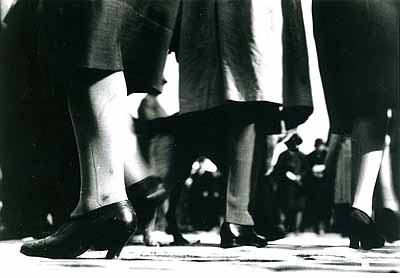
Eli Lotar »
Exhibition: 5 Jun – 5 Jul 2003
Museu do Chiado
Rua Serpa Pinto, 4
1200-444 Lisboa
MNAC: Museu Nacional de Arte Contemporânea do Chiado
Rua Serpa Pinto, 4
1200-444 Lisboa
+ 351-213-432 148

The son of the Romanian poet Ion Teodoresco, alias Tudor Arghezi, Eli Notar was born in Paris in 1905. After leaving school in Bucharest, he slipped the net of parental control to return to France in 1924, with the aim of following a career in film. He worked his way across France, taking diverse jobs, until finally, attracted by photography, he asked Germaine Krull (a German photographer living in Paris) to take him on as an apprentice and assistant. It was 1927 and from thereon his name would remain forever linked to photography. From that key moment onwards, working alongside Germaine Krull, he would develop a close acquaintance with Paris’s Bohemian life. It was thus that Lotar would come to meet, amongst others, the filmmakers René Clair, Cavalcanti and Buñuel, with whom he would later work. He rapidly became a part of the Parisian avant-garde. He developed a fondness for the flâneur, the modern city and photography… between them a reciprocal relationship was played out that appeared, for example, very explicitly in the very often convergent yet equally originating propositions that gave us, respectively, Georg Simmel on the modern city at the beginning of the century and Walter Benjamin on photography. He was attracted by the throng, the market, its stalls, the ordinary… he was interested in a city that ‘hid’ itself. Inspired by Parisian street life, he sought above all to deal with disconcerting or unusual subjects that were peculiar to the city and attracted the attention of the critic who appreciated “a daring that aimed to surprise”. Yet besides this typically picturesque quality, his photographs reveal the city’s truly modern dimension. In film, he worked as stage photographer for René Clair, Alberto Cavalcanti, Jean Renoir, Yves Allégret and Luis Buñuel, and for Jean Painlevé and Jacques and Pierre Prévert as cameraman. Aubervilliers (1946) is the only work he directed himself. Commissioned by the city of Aubervilliers, it was intended as a record of the city as it was prior to its regeneration and resulted in a cross between social documentary and photographic film. In photography as in film, in his work as in his life, Lotar, who died in 1969, was not blessed with the requisite talent to become one of the true ‘greats’. Relatively unknown, his work has only recently been studied in depth and received the attention and recognition it deserves. That it deserves it can be confirmed here in Lisbon.. ____portugues Exposição apresentada no âmbito da Lisboa Photo, uma iniciativa da Câmara Municipal de Lisboa. Filho do poeta romeno Ion Teodoresco, aliás Tudor Arghezi, Eli Lotar nasceu em Paris em 1905. Após os estudos obrigatórios, em Bucareste, escapa à tutela paternal para regressar à França em 1924, com a intenção de enveredar por uma carreira cinematográfica. “A minha vida é isto”, escreverá a um amigo residente em Paris, “o cinematógrafo e hei-de conseguir (lá chegar). Todas as hipóteses estão do meu lado.” De facto, todas as oportunidades estavam do seu lado, mesmo que ainda não o soubesse… Trabalha em diversas ocupações, percorrendo a França. Finalmente, atraído pela fotografia, pede a Germaine Krull (fotógrafa alemã a residir em Paris, que já havia colaborado com diversas revistas alemãs e belgas, e que começava a ser conhecida pelas suas fotografias de arquitectura da série Ferros) que o aceite como seu aprendiz e assistente. Estávamos em 1927 e o seu nome ficaria para sempre ligado à fotografia. A partir deste momento-chave da sua biografia, e junto de Germaine Krull, trava conhecimento com a boémia intelectual de Paris. Será assim que Lotar conhecerá, entre outros, os cineastas René Clair, Cavalcanti ou Buñuel, com quem virá a trabalhar mais tarde. Assim, rapidamente, integra-se na vanguarda parisiense. Krull, que conhece uma divulgação primeiro que Lotar e colabora, por exemplo, com a revista Vu de Lucien Vogel, transmite ao seu pupilo tanto uma visão construtiva como humana: a imagem mais simples da realidade quotidiana e o ângulo mais moderno de registo. Este, aprendendo facilmente, rapidamente se integrará, também, no universo das publicações que, então, floresciam em Paris. Entre 1929 e 1930 os seus nomes estarão associados, além da já citada Vu, a outras revistas tais como a Jazz (de Carlo Rim) ou a belga Variétés. Eles ilustram, nomeadamente, artigos sobre portos. Se Krull joga com a perspectiva, já Lotar destroi-a por um ‘achatamento’ da imagem e por um enquadramento ‘audaz’ que evoca Lazló Moholy-Nagy (i.e. Mât, 1929). Entre as muitas imagens de mar que realiza, e são numerosas, figuram aquelas que ilustram o artigo “Atterrissages et départs” de Joseph Conrad, publicado na revista Vu em 1929.

